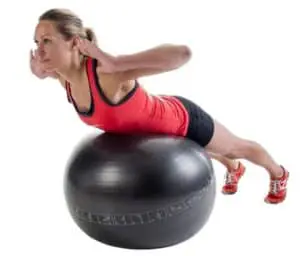I enjoy writing these articles for my readers, you guys. I don't accept payment for writing reviews, my opinion on products is my own, but if you find my recommendations helpful and you end up buying something through one of the links I may be able to receive a commission on that. More information
Whistling football matches is hard, very hard. And if you're not in optimal shape, you'll struggle to keep up with everything. You can certainly use a good start as a novice referee in amateur football.
How can you be healthy on the field, maintain your condition and possibly lose weight as a starting referee?
We have a number of tips for every level, so read on quickly to get started with your own condition.
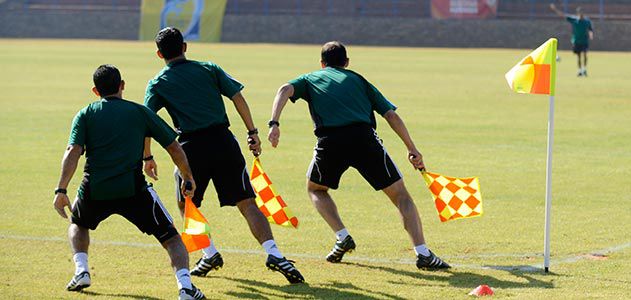
What we discuss in this comprehensive post:
- 1 How far do umpires run during a match?
- 2 How important is a good training schedule for referees?
- 3 Training for the level you are at now
- 4 What does referee training consist of?
- 5 In addition to fitness, train your muscles and balance
- 6 Compose your session and focus on different areas of interest
- 7 The warm-up
- 8 Exercises for speed and agility
- 9 Endurance Exercises
- 10 High Intensity Exercises
- 11 Exercises for your core stability
- 12 Exercises for the cool down
- 13 Rest days after intense training sessions
- 14 Nutrition for referees
- 15 Preventing Dehydration
How far do umpires run during a match?
It might first be interesting to hear how far referees actually run per match?
A football player in the Eredivisie runs about 11,2 kilometers in a 90-minute match.
A referee in the Eredivisie runs about 12,8 kilometers during a 90-minute match.
Taking good care of your body means building a good condition and taking good care of your muscles. Also read about better muscle recovery with a foam roller.
As a referee you have to be on top of the ball at all times. This strengthens your credibility towards players and of course helps to make the right decision. Players also run a lot, but spend most of the game in their own area, for example mainly in the back as a defender or up front as a striker.
How important is a good training schedule for referees?
When applying any training method, it is important to keep varying each time. Stepping up to heavier tasks is of course a good way to get fitter every time, but other variations are also important to keep the body sharp. Otherwise you really only train for one specific action, for example short sprints or endurance.
Quantity is not so important, you will progress fastest when you apply a high-quality training program. So with a few quick steps you can already do a lot for your condition and get back in shape at the same time.
In order to function well as a referee, there are a number of qualities that you need, qualities that you can work on.
We must also do our best to act better and faster. To turn more easily from a certain position or after a sprint. To be able to stop as quickly after a sprint and possibly sprint in another direction.
We can practice for this by performing movements with a higher movement speed. We can do this, for example, during the warm-up or during an exercise. Try to perform different moves in a sequence as fast as possible and combine them in order to act better.
Training for the level you are at now
Not everyone is as far along at the moment. When you just start whistling in amateur football, you may have to earn a full income. A basic training program is then best. If, on the other hand, you already whistle regularly and you want to go to a higher class, the basic training program will do nothing for you to improve your condition.
How do you determine where you are now?
At the start there are two levels to take into account:
- do you just want to build fitness?
- is it also important to get fitter, to lose weight?
When in doubt about which category you fall into, an easy and quick method is to look at your BMI (Body Mass Index).
Body Mass Index = Weight in KG / Height in Meters
| Body Mass Index | Weight category |
|---|---|
| under 20 | Underweight |
| Between 20 and 25 | Healthy |
| Between 25 and 30 | Overweight |
| Above 30 | obese |
This is of course only a very rough guide, but will give you an indication of what you can work on.
Don't do too much too quickly, how do you determine that?
You will probably start very enthusiastically with your new training schedule, very good! However, it is important not to do too much too soon. Soon you will no longer be able to whistle your match because you are in front of Pampus.
It is a good idea to monitor your heart rate while exercising. You don't want to go over your maximum heart rate. The best way to measure your maximum heart rate is with a health professional.
Not everyone will do this, especially not when you start with a low threshold. Fortunately, there is an easier way to calculate your maximum heart rate.
Your maximum heart rate = 220 – your age
This is of course also an indication.
It is recommended to start the training with a heart rate monitor. This is a handy way to keep track of your heart rate at any time.
Test your fitness level
The Cooper test is the easiest way to determine your fitness level. It gives you a general idea
of your level which involves a continuous run of 12 minutes.
This is a guide to what you should achieve as a referee:
| Distance | Level |
|---|---|
| 2200 meter | Bottom level, local amateur football on grass |
| 2500 meter | Lowest Division of National Football, Assistant Referee |
| 2700 meter | Lowest league national football, head referee |
| 2900 meter | Higher class national football |
| 3100 meter | Top class national football |
These are only indications and the requirements will change over time. But for yourself a good guideline to see where you stand and what you can handle.
Before I work out a good training program for you, here's a short summary of what a training schedule should look like.
What does referee training consist of?
Every workout you do consists of four parts:
- First, do a warm-up to loosen up your muscles.
- Then you do a core exercise aimed at developing speed.
- Then a core exercise aimed at developing endurance.
- Finally, a cool-down to avoid straining your muscles.
Depending on the number of matches you whistle per week, you can adjust your training schedule. Whenever you go on weekdays whistle, then it is best to do two intensive sessions per week. What is intensive is different for amateur referees than for the professionals. Certainly as an amateur where you also have a physically demanding job next to it, you can probably train less often. It is good to challenge your fitness at least twice a week.
In addition to fitness, train your muscles and balance
You will see that your stamina does not only depend on your fitness. Especially when walking on the field you will use muscles that you do not use much in your daily life. These will be your weak spots and you can only last as long as every single part of your body allows it.
In addition, maintaining your balance well consumes a lot of energy. So you can give your stamina a big boost by working on your balance.
In addition, as a referee, it is best to have a fairly light training the day before a football match. This allows you to activate your body for the challenge that awaits it the next day. This stimulates blood circulation and gives a healthy muscle tone.
Compose your session and focus on different areas of interest
I will cover a number of training sessions here, aimed at improving different parts of physical fitness. The sessions are categorized under the following headings:
- Speed / Agility
- Speed Endurance
- High Intensity
- Strength / Core Stability
These sessions are also level-specific so that you can train specifically to your level:
- Beginner
- Intermediate
- Advanced
You should have received a nice indication of your level with previous tests and explanations and you are now ready to plan your workout.
The warm-up
Warming up is an essential part of preparing for both training sessions and competitions. The benefits of warming up include:
- Increased rate of contraction and relaxation of heated muscles
- Decreased muscle stiffness
- More freedom of movement
- Increased blood circulation through active muscle tissues
- Allow the heart rate to rise to a workable rate before starting exercise/competition
- You also become mentally set for training or competition
A warm-up should include three main phases (15 minutes)
- General warm-up (3-5 minutes). This could include jogging at a slow and steady pace to increase heart rate and circulation.
- Dynamic stretch (5 minutes). This essentially means already ongoing stretching. You stretch like this
during the warm up and replicates the kind of movement you can expect during a match. - Specific warm-up (3-5 minutes). The final part of the warm-up is preparing for maximum effort by sprinting and raising your heart rate to about 85-90% of your maximum.
General warm up (3-5 minutes)
Walk slowly and at a steady pace around the field or back and forth from the goal line to the center line until your muscles slowly loosen and warm up.
Dynamic stretch (5 minutes)
Walk a distance between the goal line and the edge of the penalty area and always walk back to the goal line with each exercise.
High knees
Moving forward, bring your knees up to about mid-high.
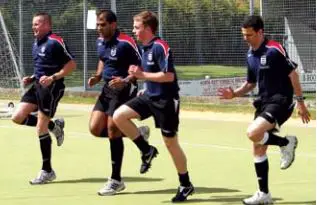
Boom Kicks
Moving forward, bring your heels up and try to hit the rear.
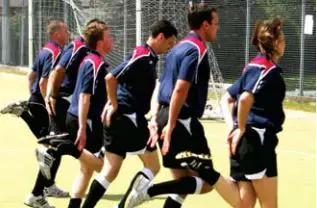
side stepping (crabbing)
Move sideways to the edge of the penalty area with one foot in front of the other.
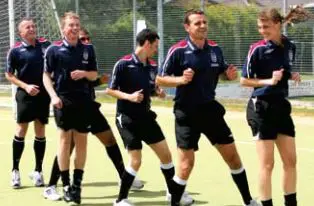
jogging backwards
Walk backwards from the goal line to the edge of the penalty area. Jog back to the goal line, then repeat.
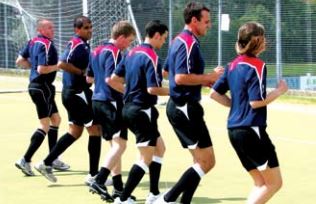
skipping
Jump from the goal line to the edge of the penalty area using a high kneecap. Jog back to the goal line. Jump to the edge of the penalty area, first your left knee and then your right across your body,
still with a high kneecap. Jog back to the goal line. Jump to the edge of the penalty area, still with a high knee lift, but turn your knee out. Jog back to the goal line. Repeat the entire sequence.
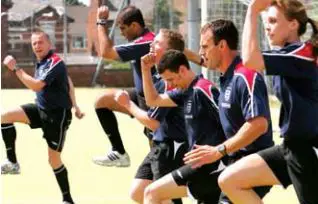
Specific warm-up (3-5 minutes)
Here you prepare for maximum effort. A good and fun way to do this is through a kind of team game. This is also a good way to build teamwork for the match and shows unity on the
playing field. Teams often do this together and you can also do this together as referees and linesmen.
The warm-up is suitable for every level as you always have to loosen your muscles.
Exercises for speed and agility
Oefening 1
In this exercise you will do short sprints. For example, you can use cones that you place 20 meters apart. With these sprints you give your maximum, aimed at improving your power.
You want to build a schedule for pulling a sprint. Follow the diagram below from cone to cone:

Keep 2 minutes between each sprint and then do another one, but watch your heart rate. Wait for your heart rate to return to 60-65% of your maximum heart rate as you slowly walk back to the start, then sprint back to the first cone.
I always measure my heart rate with my smartwatch, I have here a post about the best sports watch with heart rate monitor for field training that you can read.
A simple variation is not to place the cones in a straight line, but to push them off at a 45˚ angle with each sprint. This way you can also train your agility.
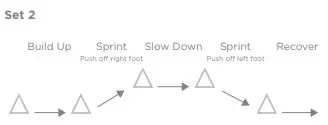
| Level | Number of reps |
|---|---|
| Beginner | 4 reps |
| Intermediate | 6 reps |
| Advanced | 8 reps |
Oefening 2
For the second exercise, you make a slightly different setup, here you can use the corners of the penalty area to build your set:
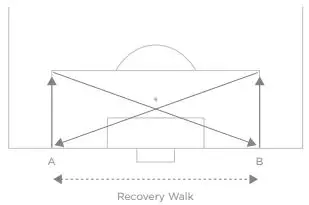
You build your speed in the first straight line, then sprint diagonally to the goal line on the other side of the goal. Also here, make sure that your heart rate returns to 60 – 65% of your maximum heart rate between repetitions.
| Level | Number of reps |
|---|---|
| Beginner | 3 reps |
| Intermediate | 5 reps |
| Advanced | 8 reps |
Oefening 3
Place several cones or sticks on the ground and space them out at varying intervals of 1-2 meters apart:
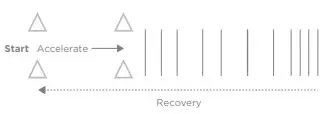
- Accelerate 15 meters from the start
- Step over each stick / cone and maintain your speed
- Slow down after reaching the last stick
- Walk slowly back to the start
| Level | Number of reps |
|---|---|
| Beginner | 8 reps |
| Intermediate | 16 reps |
| Advanced | 24 reps |
Oefening 4
Place 6 cones as shown, starting at the goal line:
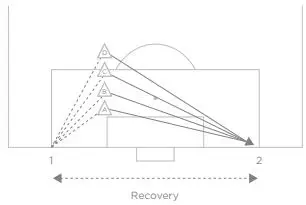
You do a different drill to each cone in the penalty area:
- Start at 1, run backwards at medium pace to cone A, then turn and do a maximum sprint to the far corner of the penalty area (2). Then walk back to 1 at a leisurely pace.
- Alternate side steps to cone B, then another maximum sprint to the far corner of the penalty area and walk back calmly.
- Jog to cone C, then maximum sprint to 2.
- Running to cone D, then maximum sprint to 2.
This represents 1 repetition. Keep an active rest for 3 minutes between reps.
| Level | Number of reps |
|---|---|
| Beginner | 2 reps |
| Intermediate | 3 reps |
| Advanced | 4 reps |
Oefening 5
Here we practice for the CODA test which is part of the FIFA Fitness Test where the ability to change direction is assessed.
Place two cones (this is the starting line), half a meter further you put down two more cones, this is point A (the starting gate). 2 meters from point A, place two more cones at point B, and after 8 meters place two more tiles at point C.
- Here you run a 10 x 8 x 8 x 10 meter sprint
- Between point A and point B is 2 meters and between point B and point C is 8 meters (from point A to C is 10 meters)
- After signal, sprint from the start line to point C
- Run sideways to the left towards point B, then right towards point C
- Normal sprint from point C to the starting gate
- Try to get the ending as close to 10 seconds
Endurance Exercises
Oefening 1
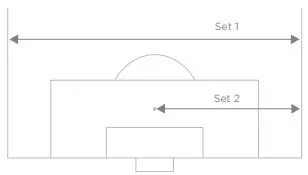
1 September: Start from the sideline and run to the opposite sideline and back again. Do this at about 80-85% of your sprinting power.
2 September: Start from the sidelines and now do the same but this time to the penalty spot
| Level | 1 September | 2 September |
|---|---|---|
| Beginner | 3 reps | 6 reps |
| Intermediate | 4 reps | 9 reps |
| Advanced | 6 reps | 12 reps |
Oefening 2
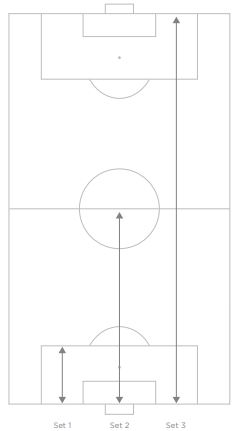
1 September: Sprint to the edge of the penalty area and back
Kit 2: Sprint to the center line and back
3 September: Sprint to the edge of the penalty area and back
Repeat the above exercise but this time start with set 3 and end with set 1.
| Level | 1 September | 2 September | 3 September |
|---|---|---|---|
| Beginner | 6 reps | 3 reps | |
| Intermediate | 6 reps | 3 reps | 1 reps |
| Advanced | 6 reps | 4 reps | 2 reps |
Oefening 3
6 x 10 second sprints at 70-80% of your maximum speed. 15 seconds of rest/recovery (slow jogging) between each sprint
| Level | Number of reps |
|---|---|
| Beginner | 2 reps |
| Intermediate | 4 reps |
| Advanced | 6 reps |
Oefening 4
Kit 1: Sprint 50 meters at 80% of your maximum speed. 25 seconds recovery
2 September: Sprint 100 meters at 80% of your maximum speed. 45 seconds recovery
3 September: Sprint 200 meters at 80% of your maximum speed. 1'30 seconds recovery
| Level | 1 September | 2 September | 3 September |
|---|---|---|---|
| Beginner | 6 reps | 3 reps | |
| Intermediate | 6 reps | 3 reps | 1 reps |
| Advanced | 6 reps | 4 reps | 2 reps |
Oefening 5
Round the field. Run the full length of the field along the sidelines. Then walk calmly to the other side of the field along the back line. Then run back the other side along the sideline, and walk out back to the start. Run at about 80-90% of your maximum speed.
| Level | Number of reps |
|---|---|
| Beginner | 6 reps |
| Intermediate | 8 reps |
| Advanced | 12 reps |
Oefening 6
Here we practice for the Repeated Sprint Ability test which is part of the FIFA Fitness Test which measures the ability to perform repeated sprints over a distance of 30 meters.
Put down two cones (this is the starting line), one and a half meters further put down two cones again, this is the starting gate. 30 meters further you put down two cones again, this is the finish gate.
- After signal, sprint at 100% of your maximum speed from the start line to the finish gate (30 meters)
- Recover for 30 seconds and walk back to the starting line
- Repeat 5 times
- Try to finish each sprint as far under 5 seconds as possible
- More professional referees cover a distance of 6 times 40 meters in 6 – 6,5 seconds with a 60 second recovery
High Intensity Exercises
Oefening 1
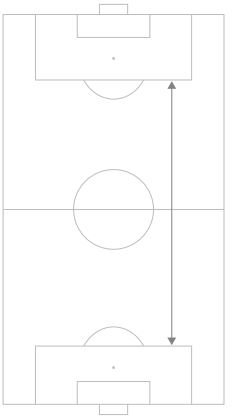
1 September: Run from one penalty area to another and back again. Run at about 60-70% of your max
2 September: Repeat the same but increase the intensity to 80-90% of your max
| Level | 1 September | 2 September |
|---|---|---|
| Beginner | 3 reps | 2 reps |
| Intermediate | 5 reps | 3 reps |
| Advanced | 6 reps | 4 reps |
Oefening 2
Beginner: run 1000 m in 6 minutes, 3 minutes slow jog, 500 m in 3 minutes, 3 minutes slow jog, 500 m in 3 minutes
Intermediate: 1000m in 5 minutes, 3 minutes slow jog, 500m in 2'30, 3 minutes slow jog, 500m in 2'30
Advanced: 1000m in 4 minutes, 3 minutes slow jog, 500m in 2 minutes, 3 minutes slow jog, 500m in 2 minutes
Oefening 3
Set up 6 cones as shown below:
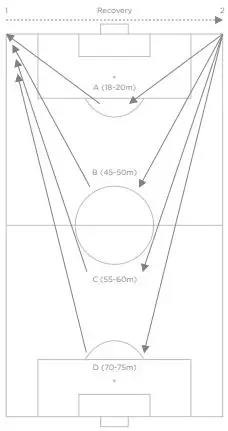
- Run from cone 2, lap A to cone 1, and slowly back again between 1 and 2
- Repeat with cones B, C & D
- Repeat the entire circuit again in reverse order (i.e. D, C, B, A)
- This is 1 repetition
4 minutes of recovery between each set
| Level | Number of reps |
|---|---|
| Beginner | 1 reps |
| Intermediate | 2 reps |
| Advanced | 3 reps |
Oefening 4
Here we practice for the Interval Test which is part of the FIFA Fitness Test which evaluates the ability to perform a series of quick runs over 75 meters alternating with 25 meter intervals.
Here we run 40 times a distance of 75 with an interval of 25 meters which is a total of 4000 meters. We can use the football lines because of the almost exact dimensions. Here we use the back lines and the lines of the penalty area.
- Start on the penalty area line near the corner
- Run 75 meters, i.e. to the penalty area line on the other side
- Stop on the penalty area line and continue to the back line and walk back to the penalty area line (25 meters in total)
- On this line of the penalty area you start running again to the other side
- Repeat until you have reached a total of 40
- Try to maintain a total of 15 seconds per 75 meters and 20 seconds per 25 meters
- You don't necessarily have to use the lines in a football field, but make sure the 40 x 75 / 25 meter distances are correct
Exercises for your core stability
In today's Health and Fitness world, it's hard to get around the term "core stability" and football training is no different. Research has shown that these core muscles are actually activated to support the spine prior to limb movement.
The goal of core stability training is to develop the ability of the core muscles to function efficiently and effectively
coordinated way to maintain proper posture.
Not only that, but it is also very important that we are more resilient to prevent possible future injuries as much as possible. In a workout, you should not omit core and core stability exercises. Do them on a weekly basis, 3 times a week if possible.
Besides that you are more resilient, this also has the advantage that you will be able to move in an easier way.
Here are some exercises you can do as part of your training program.
Superman
- Start on all fours with hands under shoulders and knees under hips.
- Put your back in neutral position and tighten your abs by contracting your navel slightly toward your spine.
- Slowly slide one leg back while moving the opposite arm forward.
- Hold it and increase this duration to a maximum of 20 seconds.
- Slowly bring your leg and arm back and switch sides.
- Perform sets of 5-10 reps.
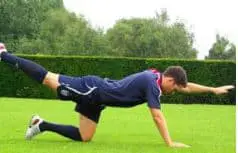
Planking
- Stretch out while leaning on your forearms
- Push yourself off the ground so that you rest on your toes and elbows
- Keep your back flat, in a straight line from head to heels
- Tilt your pelvis and contract your abs, prevent your rear end from sticking up in the air
- Hold for 20 to 60 seconds, lower back and repeat
- perform sets of 2-5 reps
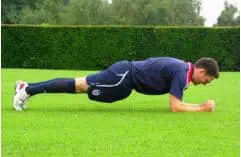
Side Shelf
- Lie on one side, elbow under your shoulder, make sure hips are even
- Both legs should remain straight and in line with the body
- Push yourself up until there is a straight line between feet, hips and head
- Hold for 20 – 60 seconds
- Lower and repeat on the other side
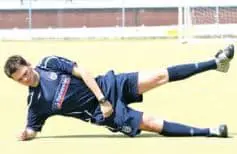
Swiss ball
- Lie with your stomach on the ball
- Put your hands behind your ears and come up from your first position
- Go back down to head position
- Repeat 15 sets of 3 with a 30 second rest
Exercises for the cool down
Achilles Stretch
Stand with one leg in front of the other, feet pointing forward, heel back on the floor with back leg slightly bent. Keep your back straight and lean back gently with your heel until you start to feel it in your Achilles tendon.
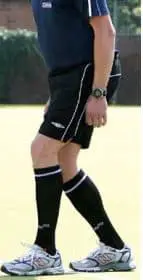
stretching calves
Stand with one leg in front of the other - slightly more than in the previous exercise - feet pointing forward. Heel on the floor and back leg straight. Keeping your back straight, bend your front knee and move your weight forward and down until you feel a stretch on the back of your calf.
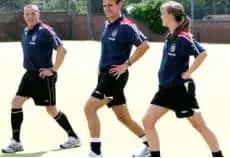
stretch thigh
Hold your foot with your hand and lift your foot up behind your buttocks. Pull the foot back and away from the buttocks and push the knee toward the floor. Use a wall or a partner if balance is an issue.
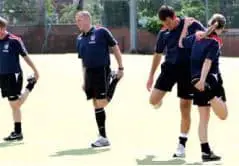
Hamstring Stretch
Stand with one leg in front of the other, feet pointing forward again. Push the hips back and keep your back as straight as possible, with your hands resting on the knee, then straighten your front leg. Then straighten by pushing your hips back and down.
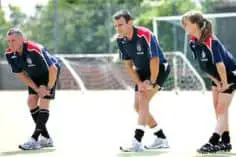
Stretching hamstring while lying down
Sit with one leg extended in front of you, with the other bent so that your foot touches the inside of your straight leg. Keep your back straight and grab the tip of your foot with your hand. Hold, exhale and move the hands back up your leg. Switch legs and repeat.
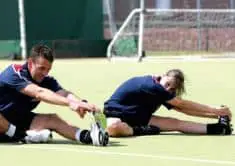
groin stretch
Stand with your feet just about shoulder-width apart. Keeping your right leg straight, bend your left knee and lean your torso toward the extended leg until you feel the stretch on the inner side of your right thigh.
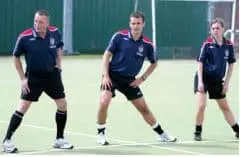
toe gripper
Start this stretch with your heels together on the floor, holding both feet with your hands. Lean forward from you
hips, gradually intensifying the stretch.
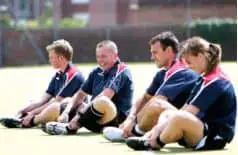
strangle shoulder
Cross one arm horizontally across your chest, grab it with your other hand or forearm, just above the elbow. Exhale slowly as you pull your upper arm in. Repeat for the other arm.
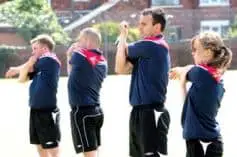
Triceps stretch
Extend one hand from the center of your back, fingers pointing downward. Use the other hand to grab the elbow. Exhale slowly and pull gently.
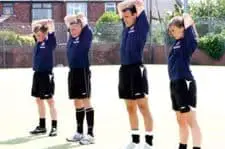
Rest days after intense training sessions
Rest is crucial in ensuring optimal physical performance. It is vital that everyone involved in
physical activity on a regular basis gives the body time to recover.
After the endurance workouts, you need about 24 hours of recovery time before you can do the same workout again. After practicing the interval training, make sure you get about 72 hours of recovery time.
Make sure that there is sufficient rest between the training sessions and the training sessions and competitions.
In all these forms, recovery from exertion is of great importance. If you are not equipped, you will certainly not go faster
start moving and the quality of the training sessions will decrease. In that case you train often (quantity) but not efficiently (quality).
Nutrition for referees
Our bodies can only perform at their capacity if we consume the right foods and fluids. This is especially important in the days/hours leading up to a match or training session.
As an amateur referee you don't have to give up all the nice things and comforts of life, but you get out of it what you put in. Especially if one of your goals is to become physically fitter and lose weight, this is something extra you could pay attention to.
Ideally, your diet should consist of the following:
Carbohydrates: Carbohydrates have several important functions. They provide both physical and mental energy for high-intensity activities such as whistle blowing or training. They are absorbed into the blood to be used as immediate energy, or stored as glycogen in the muscles and liver to be used at a later date.
glucose: the primary fuel for our brain function, using about 60% of the available glucose. So when blood sugar is low, the brain doesn't work as well as it should. Decisions
and skills are reduced and fatigue will occur. Keep the right amount of carbohydrates to
balance blood sugar and keep energy levels and weight even.
There are different types of carbohydrates, some of which dissolve slowly and provide a stable,
long-lasting source of energy. Others, which are absorbed quickly, lead to a rapid increase in blood sugars
and a wave of energy.
Good sources of slow release carbohydrates:
- Whole-weat pasta
- Whole grain bread
- Brown Basmati rice
- Oatmeal
- Muesli / All Bran
- Lentils / Soybeans / Kidney beans
- Apples / Pears / Berries
- Broccoli / Tomato / Green beans
- Smoothie drinks
Good sources of fast-release carbohydrate snacks:
- Digestive Cookies
- Chocolate
- cereal bars
- Bananas
- Potato
- Dried fruit
- Buckwheat / Couscous
- Fruit juice
- Sports drinks
Fats: are needed in the diet and have many essential functions within the body. Fats are the main energy reserve in the body and the main source of energy for low-intensity activity. Fats act as a protective shield against trauma to vital organs such as the heart, liver, kidneys, spleen, brain and spinal cord. Fats are an important part of all cell membranes, including nerves and brain cells.
Fat is essential in any diet for referees, but it is important to consume the right types of fats. Fats found in seeds, nuts and fish are essential, as are polyunsaturated fats and oils. Saturated and monounsaturated fats found in dairy products, and often fried and processed foods are considered non-essential fats and should be avoided, especially if you want to lose weight.
Protein: Protein is an essential macronutrient in the body. They are building material for bones, tendons and muscles. All enzymes are proteins. Enzymes regulate many energy-producing reactions, as well as the construction and repair of tissues, especially muscles. Protein can also act as an energy source after carbohydrate depletion after exercise, but this situation should be avoided where possible.
I always buy some mix for sports drinks, smoothies and energy bars here at Decathlon and then take my drinks in a water bottle or make them at home before a competition.
Preventing Dehydration
Muscles are 75% water. A loss of as little as 3% of water can cause a 10% reduction in strength and an 8% loss in speed, and can also impair mental focus and concentration. Sweating is a normal reaction of the body during training or competition. The inevitable result is that the body naturally loses water.
However, during exercise, thirst sensors are inhibited and you will be less likely to notice that you are thirsty, so it is imperative that referees stay well hydrated and continue to drink fluids during the match.
- Ideally, referees should drink 2 liters of water a day before a match.
- The loss of bodily fluids causes fatigue, so umpires must drink plenty of fluids during the match.
- The rule of thumb is: drink a little and often. Drink about 200 ml (a plastic cup full) and do this every 15-20 minutes. Waiting for the rest is therefore too long.
- Drink about 1 glass of water every 15 minutes in the hours leading up to a competition.
- If you drink a drink that contains caffeine, you should drink an extra glass of water.
- You can opt for an isotonic sports drink during the rest of a competition or halfway through an intensive training session for a quick replenishment of fluids.
What should your drink ideally contain?
- In hot conditions, only water should be taken. This is because the addition of carbohydrates tends to slow the rate at which water is absorbed into the blood.
- Drink a low-carbohydrate drink in the beginning followed by a normal carbohydrate sports drink during rest and another one in the last 20 minutes.
Referees also need to hydrate enough afterwards to update fluid loss. Drink fluids after the competition for at least one and a half times the loss of body weight. Ie if 1 kg of body weight is lost through sweat, drink 1,5 liters of fluid. Drink as soon as possible after training as body fluid recovery takes at least 30 minutes.
The day before the match
- Eat a high slow-release carbohydrate breakfast, eg a bowl of muesli with fruit, 1-2 pieces of whole wheat toast (with jam, marmalade or honey if you prefer), and a glass of fruit juice.
- It is important to drink more during the day (water, juices, sports drinks, etc.).
- Eat 2-3 "carb snacks" throughout the day.
- Before your main meal (evening) – eat a meal based around high slow-release carbohydrate foods.
Match day
- Eat a slow-release carbohydrate breakfast like the previous day.
- Eat a slow-release meal before your pre-match meal 3-4 hours before the start.
- Continue eating 'carbohydrate snacks' up to 1 hour before the race.
After the match
- Eat a carbohydrate snack as soon as possible after a competition or training, e.g. a banana,
digestive biscuits, etc. - Eat a carbohydrate-based meal within 2 hours of the game or training session.


